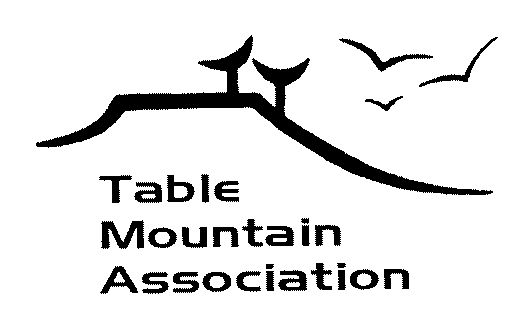

GEOLOGY OF THE TABLE MOUNTAIN AREA
Suzanne Webel
It's a pretty safe bet if you live in the Table Mountain area that you have more than your share of rocks under your feet. Have you ever wondered about what they're doing there?
While the mesa dominates much of our viewscape today, let's look at how it fits into the geological "big picture." Sometimes it's useful to think of the whole assemblage of rocks as a house.
The basement which underlies our part of Colorado is composed of ancient Precambrian granites approximately 1.5 billion years old. The basement has undergone many episodes of uplift and subsidence, with an important one occurring about 370 million years ago, forming a mountain range, in approximately the same location as today's Rockies, called the "Ancestral Rocky Mountains."
These mountains eroded quickly (in the otherwise relatively slow geological scheme of things), shedding vast amounts of coarse debris eastward which was deposited in deltas and alluvial fans. These sediments later hardened into the conglomerate we call the Fountain Formation, which is well displayed as Boulder's Flatirons and at the Hall Ranch Open Space. Subsequent, finer-grained sediments were deposited mostly as sandy beaches with intervening mudflats (the Lyons formation, which is used to face the buildings at the University), which all together make up the first floor of our geological house.
The Cretaceous period deserves the entire second floor. A vast seaway extended all along the Rocky Mountain front from Canada to Mexico. Dinosaurs frolicked on the beaches and left their footprints in the Dakota sandstone outcrops. Occasional offshore reefs resulted in limestones like the Niobrara, which is now being mined for cement at Dowe Flats east of Lyons. The Cretaceous is best known around Table
Mountain as the black shales of the Pierre Formation, which can reach 6,000 feet in thickness. The Pierre shale is also known for its swelling clays, which can cause engineering headaches in foundations, roads, and bridges. If you live on the Pierre shale, you'll know it.
Renewed uplift of the Rocky Mountains about 70 million years ago resulted in folding and faulting of the Cretaceous rocks. These forces may still continue today, as friction along faults can create warm springs such as those at Rabbit Mountain, whose waters were piped all the way to Hygiene to supply the sanitarium there. A flurry of oil drilling just after the turn of the century east of the Lake Valley Golf Course discovered geothermal hot water (300 degrees Fahrenheit at 1500 feet), which still flows to the surface under artesian pressure and creates a wetland that never freezes, making the area a prime winter haven for wildlife.
Most of us live on the roof. The Quaternary period was marked by another major outpouring of coarse sediments which were shed eastward from the mountain front. These sediments contain a hodge-podge of rocks of all types, from whatever source happened to be uphill: granite, gneiss, quartzite, limestone, and sandstone. Dinosaurs had given way to woolly mammoths and saber-toothed tigers; glaciers covered much of North America in the Pleistocene epoch. The oldest, barely-consolidated gravels and conglomerates of this period in our area are called the Rocky Flats Alluvium, which rests "unconformably" (not parallel) on the Pierre shale. Believe it or not, the very top of Haystack Mountain is all that is left of a vast sheet of Rocky Flats Alluvium (sorry, folks, this little pinnacle is not a volcano!). Other places to see this formation are the top of Gunbarrel Hill and the type location, Rocky Flats, along Highway 93 toward Golden.
Younger still is the Verdos Alluvium, which is marked by brown sand and gravel, with pebbles, cobbles, and boulders which are weathered and
decomposed. Caliche, a hard, calcareous cement, fills old cavities and coats many of the stones, making this formation resistant to erosion (and to agriculture!). The Verdos comprises some of the topographic benches on the west side of Table Mountain, as well as "holding up" the mountain itself. If you live just east of Table Mountain and have a lot of boulders in your soil, they are erosional remnants of the Verdos Formation, which may once have extended as far east as Longmont. And yes, even though the top of Haystack Mountain is slightly higher than the top of Table Mountain, it's older.... That's the vagaries of geology for you.
If you live in the Lefthand Valley or on parts of the outwash plains near the Altona Grange you are probably lucky enough to be sitting on the still younger Slocum or Louviers Alluvium, which are considerably finer-grained and more conducive to vegetation. The best agricultural land, however, occurs along the Diagonal and east of Longmont all the way to Kansas. It is underlain by eolian (windblown) deposits which are still being deposited today, as it consists of the topsoil all the rest of us lose every time the wind blows!

The diagrammatic cross-section above extends from the Heil Ranch on the northwest, across Table Mountain and Haystack Mountain, to the Diagonal Highway at IBM on the southeast. By projecting in where you live along this imaginary line, you can pretty well predict what kind of geology lies under your feet. If you would like additional information, I'd be happy to try to help or to steer you toward published references that might help -- and if you know of any interesting geological tidbits for me, please give me a call!
Suzanne Webel 303-499-0786